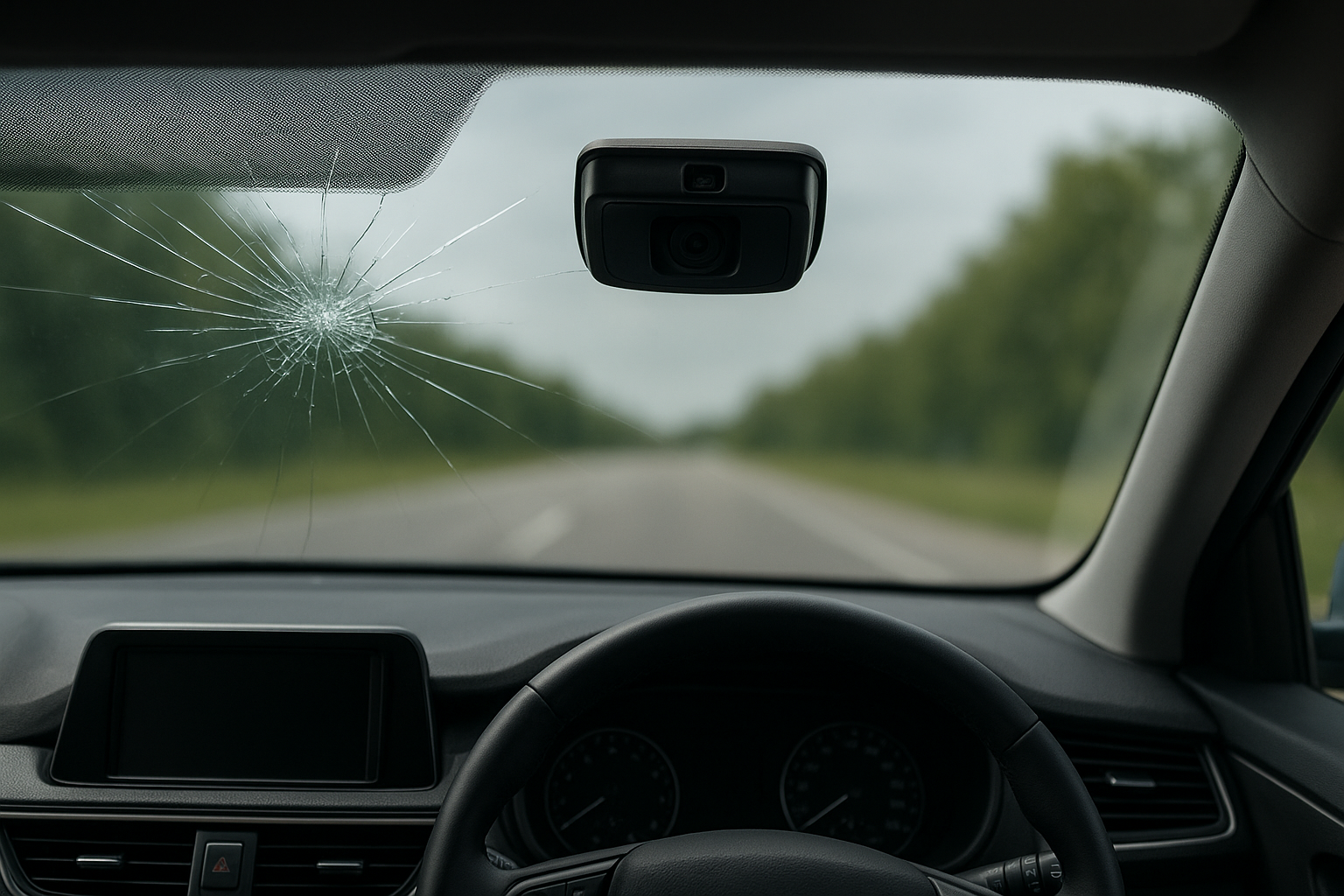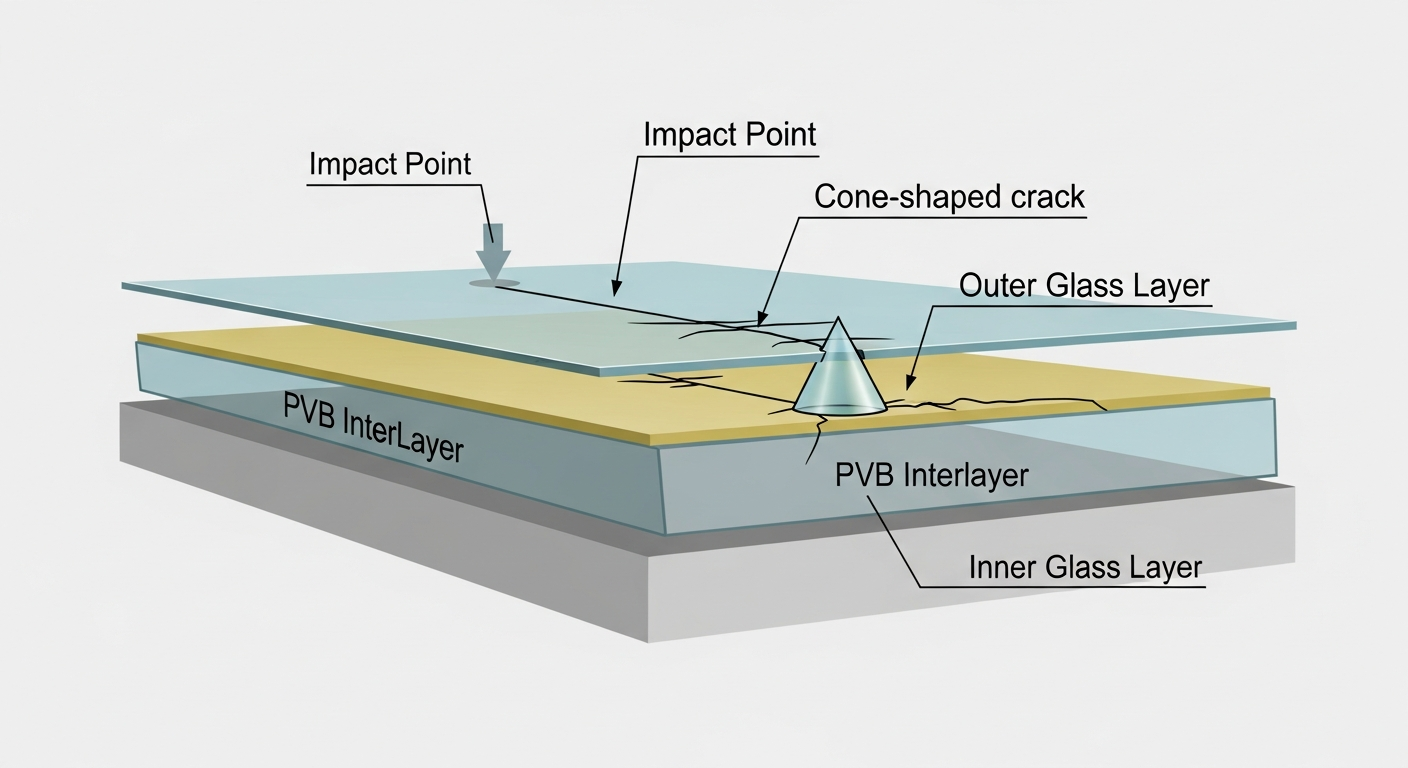My Windshield Has a Bullseye Crack. Can It Be Repaired, or Do I Need a Full Replacement?

It’s a sound every driver dreads: the sharp thwack of a stone against the glass, leaving behind a tell-tale mark. When that mark is a perfect circle, you're looking at a bullseye crack. Your first thought might be the cost and hassle of a full windshield replacement. But what if you didn't have to? That small, circular blemish on your auto glass often presents a critical choice: a quick, affordable repair or a more involved and costly replacement.
This comprehensive guide will walk you through everything you need to know about this specific type of windshield damage. We'll explore what a bullseye crack is, what factors determine its fate, and how you can make the safest and most cost-effective decision for your vehicle. Understanding your options can save you time, money, and ensure your car remains structurally sound.
What Is a Bullseye Crack?
A bullseye crack is one of the most common and recognizable types of windshield damage. As its name suggests, it resembles a target, featuring a dark, circular impact point with a cone-shaped break in the outer layer of the glass. Often, a small piece of glass is scooped out at the center, creating a pit. These are typically caused by the impact of a blunt object, like a piece of gravel or a small rock, striking the windshield.
To understand why a bullseye is often repairable, you need to know how your windshield is constructed. It's made of laminated glass two layers of glass bonded together by a central layer of polyvinyl butyral (PVB). A bullseye crack usually only affects the outer layer, leaving the inner PVB layer and the interior glass intact. This structural design is what contains the damage and makes a targeted chip repair possible, preventing the need for a completely new windshield. These initial impacts are also referred to as windscreen chips or crack chips.

A bullseye crack typically only damages the outer layer of the laminated windshield, leaving the crucial PVB interlayer and inner glass unharmed.
What Causes Bullseye Cracks to Form
The primary cause of a bullseye crack is a direct impact from road debris. However, several factors contribute to their formation and severity:
There are two primary methods for recalibration:
- Road Debris: The most frequent culprit is gravel, stones, or other hard objects kicked up by the tires of vehicles in front of you, especially on highways or construction routes.
- Sudden Temperature Changes: Extreme temperature shifts can create a stress crack. If your glass has a tiny, unnoticed impact point, blasting the air conditioning on a hot day or the defroster on a freezing day can cause the glass to expand or contract rapidly, turning a micro-chip into a noticeable bullseye.
- Structural Stress: The flexing of a vehicle's frame while driving over potholes, speed bumps, or uneven terrain can put pressure on the windshield, exacerbating existing weak spots.
- Direct Impact: Accidental impacts, such as from hail or even a tool dropped during maintenance, can easily create these circular windscreen cracks.
Can a Bullseye Crack Be Repaired?
Yes, in most cases, a bullseye crack is highly repairable. It is one of the easiest types of damage for an auto glass technician to fix. The success of a windshield repair depends on a clear set of criteria that professionals use to assess the damage.
A bullseye crack is generally considered a good candidate for repair if it meets these conditions:
- Size: The impact zone is typically smaller than a quarter (about 1 inch or 2.5 cm in diameter).
- Depth: The damage has not penetrated through the PVB inner layer to the second layer of glass.
- Location: The crack is not in the driver’s direct line of sight, as the repair process can leave a minor distortion. It should also not be too close to the edge of the windshield.
- Contamination: The impact point is relatively clean and free of dirt, moisture, or other debris that could interfere with the resin bonding process.
Unlike a star crack (which has radiating legs) or a half-moon crack (a semi-circular break), the self-contained nature of a bullseye makes it ideal for a glass repair process where resin can completely fill the void.
When Replacement Becomes Necessary
While repair is often the preferred route, certain situations demand a full replacement to ensure driver safety and vehicle integrity. A
windshield replacement becomes unavoidable if:
- The Size is Too Large: If the bullseye is larger than a quarter or has started to develop a long crack extending from its perimeter, it is generally considered unrepairable.
- The Damage is Deep: If the impact has penetrated both layers of glass, the windshield's structural integrity is compromised beyond what a repair can fix.
- It's an Edge Crack: If the bullseye is too close to the edge of the windshield (typically within two to three inches), it can weaken the entire structure and the bond between the glass and the vehicle frame.
- It's a Combination Crack: Sometimes, a bullseye is part of a more complex pattern, like a bullseye with radiating lines (a combination break) or multiple crack splits. These are too unstable to repair reliably.
- The Damage Obstructs Vision or Sensors: If the crack is directly in the driver’s line of sight or interferes with Advanced Driver-Assistance Systems (ADAS) cameras and sensors, replacement is the only safe option.
The Importance of Timely Action in Vehicle Related Issues
Ignoring a bullseye crack is a significant mistake. What starts as a minor issue can quickly escalate. The vibrations from daily driving, temperature fluctuations, and even the pressure from a car wash can cause the crack to expand.
Once dirt, moisture, and debris enter the impact point, they contaminate the area and prevent the repair resin from bonding properly with the glass. This contamination significantly reduces the chances of a successful and visually clean repair. A small, fixable bullseye can easily grow into a large, unrepairable long crack, forcing a more expensive full replacement. Acting quickly is the single most important factor in saving your windshield.
What Happens During a Professional Repair
The professional repair of a bullseye crack is a precise and effective procedure that restores both the strength and clarity of your windshield. When you call on auto glass repair specialists, they will follow a meticulous repair process:
- Assessment and Cleaning: The technician thoroughly inspects the windshield damage to confirm it is repairable. They then carefully clean the impact point, using a vacuum process to remove any air, moisture, and debris from the crack.
- Resin Injection: A special tool is mounted over the bullseye to create a vacuum seal. A high-quality, clear liquid resin is then injected under pressure, forcing it deep into every crevice of the crack.
- Curing: Once the crack is filled, a UV light is placed over the area. This light cures and hardens the resin in minutes, creating a powerful bond with the surrounding glass. This is the essence of modern spot windshield repairs.
- Polishing: Any excess resin is scraped off, and the surface is polished until it is smooth and level with the rest of the windshield.
Contact us, book your slot, and get your windscreen repaired as quickly as possible.
This entire process typically takes less than 30 minutes, and the result is a structurally sound windshield with the blemish reduced to a faint, barely noticeable spot.
Cost and Time Difference of Windscreen Repair vs Replacement
When deciding between repair and replacement, the differences in cost, time, and convenience are significant.
| Factor | Windshield Repair | Windshield Replacement |
|---|---|---|
| Average Time | 20-45 minutes | 1.5-3 hours (including adhesive cure time) |
| Cost | Significantly lower. Often fully covered by insurance with no deductible. | More expensive, typically requiring a deductible payment. |
| Structural Integrity | Restores 80-95% of the original strength. | Restores 100% of the original strength. |
| Insurance | Many policies waive the deductible for repairs. | Almost always requires paying your comprehensive deductible. |
| Environmental Impact | Eco-friendly; keeps the original glass out of landfills. | Creates waste from the old windshield. |
How to Prevent the Crack from Worsening Before Repair
If you get a bullseye crack and can't schedule an immediate repair, take these temporary steps to protect it:
- Cover the Crack: Place a piece of clear packing tape over the impact point. This will keep dirt and moisture out.
- Avoid Extreme Temperatures: Park your car in a garage or shaded area. Avoid blasting the defroster or A/C directly onto the windshield.
- Drive Gently: Avoid slamming doors and driving over potholes or rough roads, as vibrations can cause the crack to spread.
- Postpone Car Washes: Do not wash your car. Water pressure can force moisture deep into the crack.
- Be Wary of DIY Repair Kits: While a Windshield Repair Kit might seem like a cheap fix, improper application can trap air, result in a weak bond, and make a future professional repair impossible. It's best left to the experts.
Frequently Asked Questions
1. Can a bullseye crack repair last long-term?
Yes. A professional repair using high-quality resin is a permanent solution. It will restore the structural integrity of the glass and prevent the crack from spreading for the life of the windshield.
2. Is a bullseye crack different from a star crack or half-moon crack?
Yes. A bullseye is circular, while a star crack has lines radiating from a central point. A half-moon crack (or Halfmoon cracks) is a semi-circle. While the repair approach is similar, bullseyes are generally the easiest to fill completely. Other damage types include floater cracks (cracks that start in the middle of the glass, not from an edge) and stress cracks.
3. Does my insurance cover the repair?
Most comprehensive auto insurance policies cover the full cost of a windshield repair without requiring you to pay a deductible. They do this to encourage quick action, as a repair is much cheaper for the insurance company than a full replacement. For a replacement, you will likely have to pay your deductible. It's always best to review your policy or file a windshield insurance claim to confirm the details and insurance paperwork needed.
4. How soon can I drive after a repair?
You can typically drive your car immediately after a repair is completed, as the UV curing process hardens the resin instantly.
Don’t Delay Professional Assessment
A modern windshield is far more than a barrier against wind and rain; it’s a critical safety component of your vehicle. It provides up to 30% of your vehicle’s structural strength, supports airbag deployment in a collision, and helps prevent the roof from collapsing in a rollover.
Even a small bullseye crack compromises this system. Delaying an assessment is a gamble with your safety. A quick inspection by a certified technician can give you a definitive answer based on industry safety standards, removing guesswork and ensuring you make the right choice.
Final Thoughts
A bullseye crack on your windshield doesn't automatically mean you need an expensive full replacement. If the damage is small, shallow, and located away from critical areas, a quick and affordable windshield repair is often the best solution. This process restores the glass's strength, prevents the crack from spreading, and is frequently covered entirely by your insurance.
However, safety must always be the priority. For larger, deeper, or poorly located cracks, a windshield replacement is the only responsible option. The key takeaway is to act fast. A timely professional assessment can turn a potentially major problem into a minor inconvenience, keeping you safe on the road.
